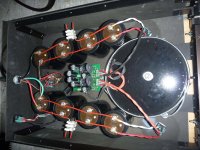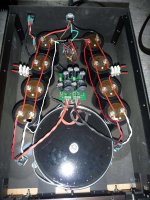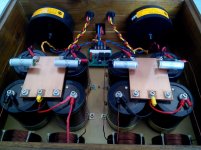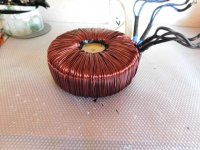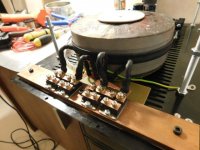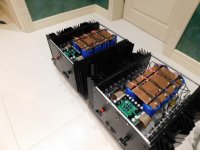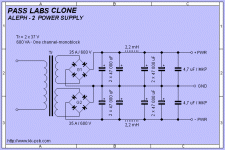btw. you made it really Fugly! 
maybe I'm wrong ..... in fact , I don't care - I'm not wrong - anyone using speakers hard to drive is , well, masochist by nature ...... considering wast number of good speakers easy to drive
you have enough material there to drive DMT215 biamplified ..... or even 3-amplified .... 6 proper channels in one case .......
pass those Daytons to someone who doesn't know better , or at least - easier

maybe I'm wrong ..... in fact , I don't care - I'm not wrong - anyone using speakers hard to drive is , well, masochist by nature ...... considering wast number of good speakers easy to drive

you have enough material there to drive DMT215 biamplified ..... or even 3-amplified .... 6 proper channels in one case .......
pass those Daytons to someone who doesn't know better , or at least - easier
Thanks! Coming from you thats a huge compliment! 😀
You think thats bad, here is the PSU 😛 I put so many uF of caps had to add in a slow charge circuit on top of the soft start so that i wouldn't blow a fuse 😀
Yeah the Watson's weren't mine. After I built it, I just had to take it over to my buddy's place just to see how they perform. You know.... stress testing.... needless to say we were impressed how detailed and how much bass the amp was able to push out of those speakers.
You think thats bad, here is the PSU 😛 I put so many uF of caps had to add in a slow charge circuit on top of the soft start so that i wouldn't blow a fuse 😀
Yeah the Watson's weren't mine. After I built it, I just had to take it over to my buddy's place just to see how they perform. You know.... stress testing.... needless to say we were impressed how detailed and how much bass the amp was able to push out of those speakers.
Attachments
Last edited:
OK I can try that.
Whats the reason for wiring like that?
good looking wiring is nice for your eyes 😀 some says copper plate will enrich the sound (you should not believe this)
those big black caps are Kendeil ?
Attachments
Yes, they are Kendeil caps.
I forgot the reason, but some here think copper plates aren't has good as twisted wire, for noise issues. In fact, the fact that I didn't twist the wire between the caps is already a compromise... but hey, the AC - DC conversion is already done in a separate box anyways so... 😛
I forgot the reason, but some here think copper plates aren't has good as twisted wire, for noise issues. In fact, the fact that I didn't twist the wire between the caps is already a compromise... but hey, the AC - DC conversion is already done in a separate box anyways so... 😛
Hi TorH ,
Can you tell me please , if your transformer (Toroidy) is silent?
Unfortunately, at a bias of 3.6A, I had both transformers (Toroidy-2500VA) a very strong mechanical noise. I tried all the variations (DC filter, snuber, CRC, CLC) but to no avail. I had to take them off external isolation and pour it completely in resin. Buzz went completely In one transformer in the second I have a little buzz.
Thank you🙂
Can you tell me please , if your transformer (Toroidy) is silent?
Unfortunately, at a bias of 3.6A, I had both transformers (Toroidy-2500VA) a very strong mechanical noise. I tried all the variations (DC filter, snuber, CRC, CLC) but to no avail. I had to take them off external isolation and pour it completely in resin. Buzz went completely In one transformer in the second I have a little buzz.
Thank you🙂
Attachments
psu ?
hello, congratulations x your wonderful achievement. I have a couple of questions about your F5 v3, I saw that he used a 4x36v transformer, but it should not be 24v x F5? ' i ask you xche i would have 2 600w 2x37v transformers and also capacitors from 47000uf (from an Aleph 2) .. i can ask for PSU scheme ?? so I can build it myself too thank youBig caps and big transformer.
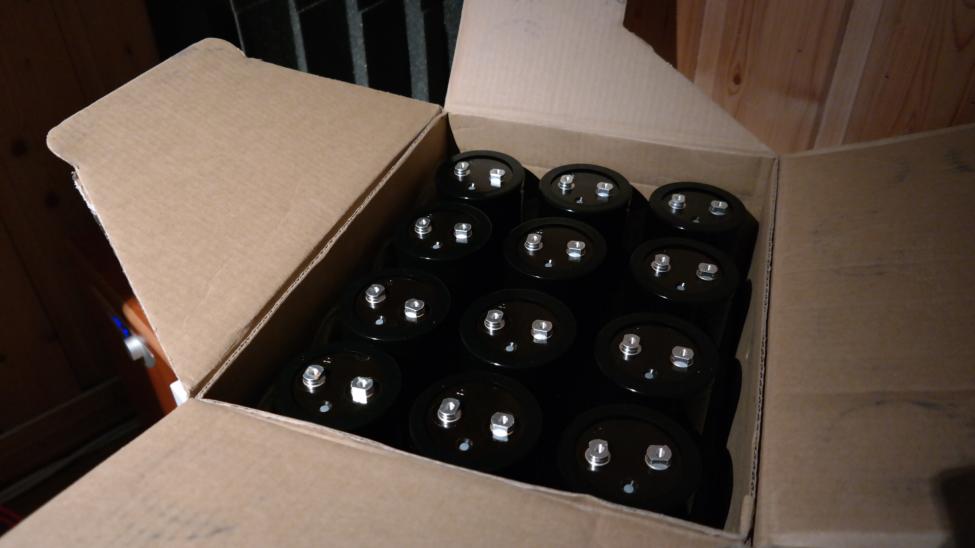


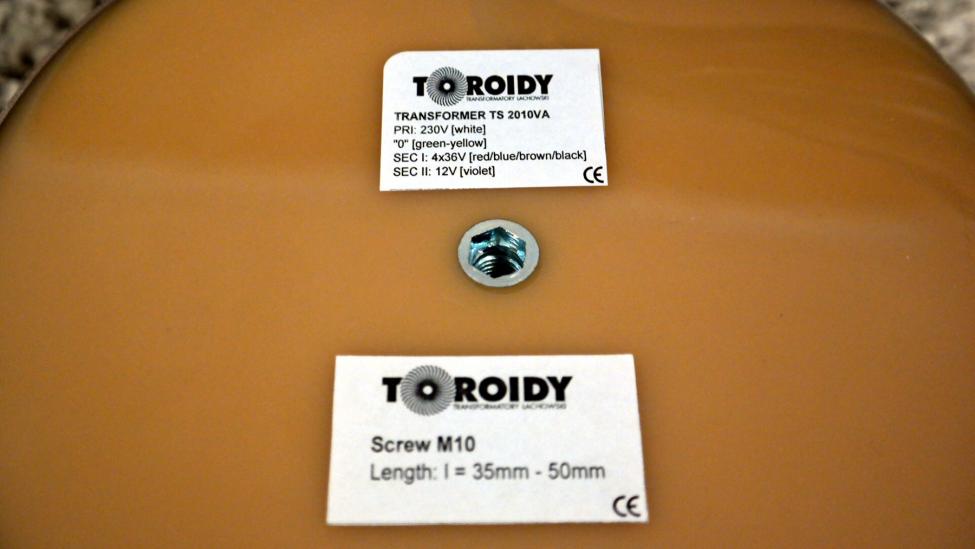
dual 36Vac allows about 100W into 8ohms and probably a bit more, maybe as high as 120W 8r.
The bias is turned up as high as the heatsinks will allow, upto a maximum of around 2.6A (same as the Krell ksa100)
The bias is turned up as high as the heatsinks will allow, upto a maximum of around 2.6A (same as the Krell ksa100)
sorry my ignorance, you are saying that, x v3 can i use 36v simply by setting bias ?? if so I could use it like a psu like that of aleph 2 ??🙂dual 36Vac allows about 100W into 8ohms and probably a bit more, maybe as high as 120W 8r.
The bias is turned up as high as the heatsinks will allow, upto a maximum of around 2.6A (same as the Krell ksa100)
OK, dual 36Vac will give about +-50Vdc to +-52Vdc on the supply rails when an amplifier with low quiescent current is powered on.
This will drop when more current is drawn.
Typically you can expect a ClassAB amplifier on BJT devices to give between 100W and 120W into 8ohms.
When powering a high bias amplifier including ClassA, the supply rails will drop a few volts.
But the big difference is that these high quiescent current amplifiers when pulling full power test signals do not pull the supply rails down as much as a ClassAB low bias amplifier.
i.e. they start with a lower supply and end up with a very similar supply when on full power.
Thus you can expect a ClassA amplifier to deliver a very similar maximum power as a ClassAB amplifier because the supplies at the amplifier supply pins are very similar when under full load.
The amount of ClassA current available depends on the output bias you have chosen to set up.
Using the standard equation P = Ipk^2 R/2 gives the following.
1Apk into 8ohms is equivalent to 4W
1.4Apk = 7.8W
2Apk = 16W
2.5Apk = 25W (F5 with ~ 1.3A total output bias)
3Apk = 36W
3.6Apk = 51W (Krell ksa50 with 1.9A total output bias)
5.6Apk = 100W (Krell kas100 with 2.9A total output bias)
With an F5t the Builder chooses the total output bias and this is generally limited by how hot the heatsinks will be allowed to get.
This will drop when more current is drawn.
Typically you can expect a ClassAB amplifier on BJT devices to give between 100W and 120W into 8ohms.
When powering a high bias amplifier including ClassA, the supply rails will drop a few volts.
But the big difference is that these high quiescent current amplifiers when pulling full power test signals do not pull the supply rails down as much as a ClassAB low bias amplifier.
i.e. they start with a lower supply and end up with a very similar supply when on full power.
Thus you can expect a ClassA amplifier to deliver a very similar maximum power as a ClassAB amplifier because the supplies at the amplifier supply pins are very similar when under full load.
The amount of ClassA current available depends on the output bias you have chosen to set up.
Using the standard equation P = Ipk^2 R/2 gives the following.
1Apk into 8ohms is equivalent to 4W
1.4Apk = 7.8W
2Apk = 16W
2.5Apk = 25W (F5 with ~ 1.3A total output bias)
3Apk = 36W
3.6Apk = 51W (Krell ksa50 with 1.9A total output bias)
5.6Apk = 100W (Krell kas100 with 2.9A total output bias)
With an F5t the Builder chooses the total output bias and this is generally limited by how hot the heatsinks will be allowed to get.
Last edited:
in practice you are saying that with proper dissipators and calibration bias, x build f5 turbo v3 I could use the 2x36 transformers and my capacitors 47000uf of my Aleph 2? if so, can not you give me an example of PSU?OK, dual 36Vac will give about +-50Vdc to +-52Vdc on the supply rails when an amplifier with low quiescent current is powered on.
This will drop when more current is drawn.
Typically you can expect a ClassAB amplifier on BJT devices to give between 100W and 120W into 8ohms.
When powering a high bias amplifier including ClassA, the supply rails will drop a few volts.
But the big difference is that these high quiescent current amplifiers when pulling full power test signals do not pull the supply rails down as much as a ClassAB low bias amplifier.
i.e. they start with a lower supply and end up with a very similar supply when on full power.
Thus you can expect a ClassA amplifier to deliver a very similar maximum power as a ClassAB amplifier because the supplies at the amplifier supply pins are very similar when under full load.
The amount of ClassA current available depends on the output bias you have chosen to set up.
Using the standard equation P = Ipk^2 R/2 gives the following.
1Apk into 8ohms is equivalent to 4W
1.4Apk = 7.8W
2Apk = 16W
2.5Apk = 25W (F5 with ~ 1.3A total output bias)
3Apk = 36W
3.6Apk = 51W (Krell ksa50 with 1.9A total output bias)
5.6Apk = 100W (Krell kas100 with 2.9A total output bias)
With an F5t the Builder chooses the total output bias and this is generally limited by how hot the heatsinks will be allowed to get.
in practice you are saying that with proper dissipators and calibration bias, x build f5 turbo v3 I could use the 2x36 transformers and my capacitors 47000uf of my Aleph 2? if so, can not you give me an example of PSU?
Don't take my opinion in the wrong way, but if you need help making this sort of decision and consideration then you should be building an easier project.
The f5tv3 is not a beginner project exactly because of all the design and setup considerations needed.
Hi TorH,
I really like your project, congratulations!
I want to ask you, between the large plate (10mm thick) and heatsink... you put thermal paste?
I have the same casse. I used thermal paste between:
- Aluminum plate and insulator Al2O3 (IRFP240 / 9240);
- Between thick plate and heatsink.
Maybe I'm wrong, but at a bias of 3.6 A heatskins temperature is around 48 ... 50 C.
Vitalica, which PCB's did you use for this F5Tv3? They look very nice...
hi, well; I usually build speakers from the Toels site, in fact I started building the Ekta great, but, long ago thanks to the help of a friend I met in a Forum, I successfully realized my Aleph 2 ... I found forums not do they also serve this?😀 if you have patience to bear me 😱🙂🙁🙄 thank youDon't take my opinion in the wrong way, but if you need help making this sort of decision and consideration then you should be building an easier project.
The f5tv3 is not a beginner project exactly because of all the design and setup considerations needed.
- Status
- Not open for further replies.
- Home
- Amplifiers
- Pass Labs
- Stereo F5 Turbo V3
